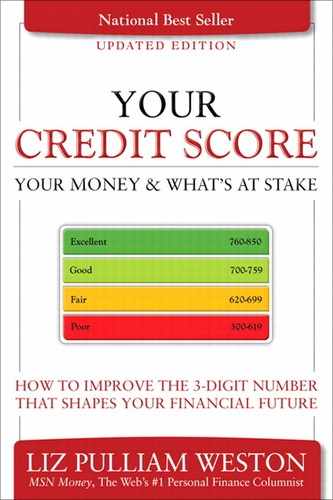“In recent years, a simple three-digit number has become critical to your financial life.”
That is the sentence that opens Chapter 1 of this book. In previous editions, the statement was a surprise to many readers.
Although most people had heard of credit scores, I’d found relatively few really understood the pervasive impact these numbers have in our financial systems and our day-to-day lives.
Now, their impact is obvious, thanks to the financial crisis that began in 2008.
In the years leading up to the implosion, lenders that had once used credit scores as a factor in their decisions started to rely on them almost exclusively, ignoring other important details such as the borrower’s income, assets, job stability, and other debts.
Lenders made riskier and riskier loans thanks to their over-reliance on credit-scoring formulas. Wall Street encouraged the gambles by snapping up massive bundles of this toxic debt and selling them to investors. Financial firms compounded their exposure with complicated financial instruments, including derivatives and credit default swaps.
As mortgage defaults rose, the effects boomeranged through the financial industry. Suspicion spread that banks and Wall Street firms were hiding the true impact of bad loans on their bottom line, causing investors to bail and once-chummy firms to stop lending to one another.
The credit crisis quickly became a conflagration that spread throughout the global economy, destroying Wall Street behemoths and leading to unprecedented government interventions and bailouts.
Yet this calamity didn’t undermine the importance of credit scores for consumers. They’re more crucial than ever.
As the crisis grew, the world split into two, with one set of rules for the credit “haves” and another for the “have nots.”
People who didn’t have good credit scores saw their options dwindle as the lenders that once courted their business were forced into bankruptcy. The banks and credit card issuers that remained grew wary of taking any risk, particularly with borrowers who had trouble paying their bills in the past.
By mid-2008, for example, auto lenders were approving fewer than one in four applications from would-be car buyers with bad credit. A year earlier, those lenders had approved two out of three borrowers with the same poor scores.
Rejection rates soared for mortgages and other loans, as well. Credit card issuers began raising rates and lowering limits first on their highest-risk customers, then on those with better credit.
But people who had the highest scores still had plenty of options.
Lenders need to make loans to make money, so they concentrated their efforts on the people most likely to pay them back. Credit card issuers, in particular, continued to pelt these desirable consumers with low-rate offers. Savvy borrowers quickly discovered that if their current issuer wouldn’t rescind a rate increase or restore a credit limit, they could just go to a competitor.
Other kinds of lenders eagerly catered to this low-risk crowd, as well. Folks with high scores could still secure low-rate car loans, private students loans, and mortgages (even though home loans generally required higher down payments than in the recent past).
Lending standards may loosen as time passes, but they’re unlikely to return soon to the anything-goes excesses that triggered the financial crash. So while credit scores won’t be the only factor in lenders’ decision making, they’ll retain a major role in who gets credit and how much it costs.
So—now more than ever—knowing how to fix, improve, and protect your credit score are essential skills for successfully navigating your financial life.
